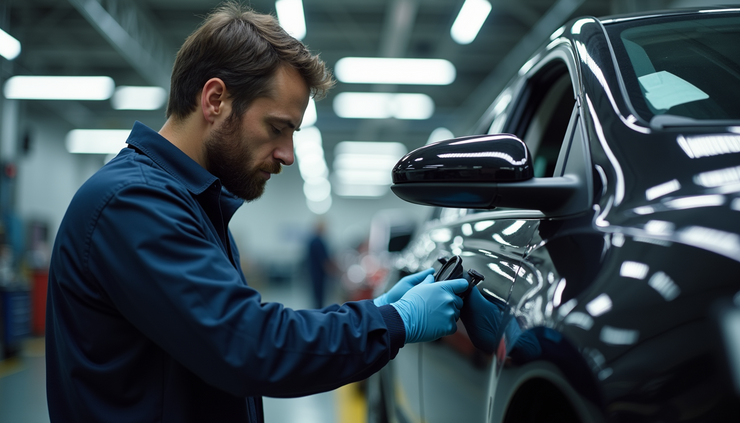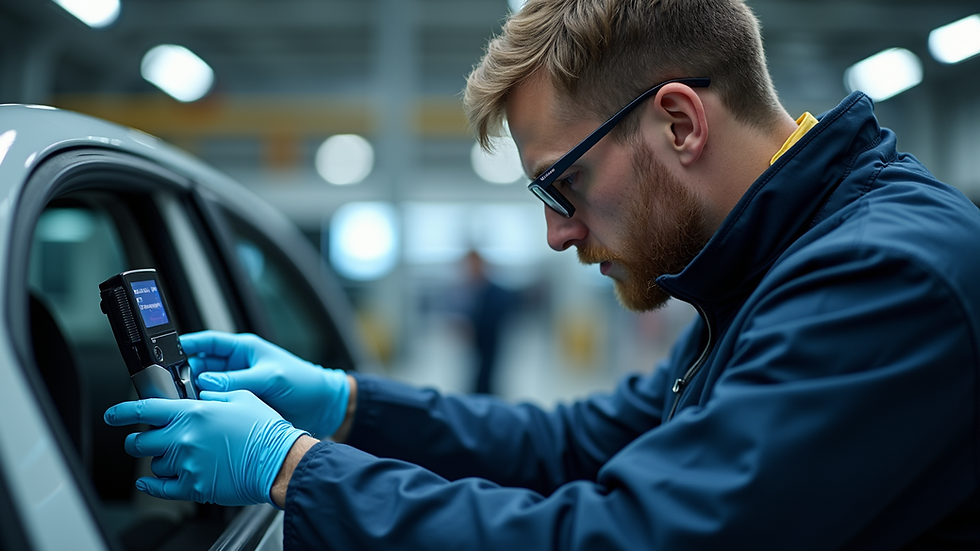Mastering ADAS: The Crucial Role of Identification, Documentation, and Calibration in Collision Repair
- Ryan DeMarco
- 2 days ago
- 3 min read
Advanced Driver Assistance Systems (ADAS) have transformed vehicle safety by helping prevent accidents and protecting occupants. These systems include features like lane departure warnings, adaptive cruise control, automatic emergency braking, and blind-spot detection. When a vehicle with ADAS is involved in a collision, proper repair is not just about fixing visible damage. It requires careful identification, documentation, and calibration of these safety systems to ensure they function correctly after repair.
Ignoring or mishandling ADAS during collision repair can create serious safety risks and expose repair shops, insurance partners, and vehicle owners to liability. This post explains why every step—from identifying ADAS features to calibrating sensors—matters. It also highlights how DriveGuardian ADAS & Diagnostic Services supports collision repair professionals with OEM-compliant processes that protect safety and compliance.
Identifying Every ADAS Feature Accurately
Collision repair begins with a thorough understanding of the vehicle’s ADAS components. Modern vehicles may have dozens of sensors, cameras, and radar units integrated into bumpers, windshields, and mirrors. Each system requires specific handling during repair.
Why identification matters
Failing to identify all ADAS features can lead to incomplete repairs. For example, a shop might replace a damaged bumper but overlook a radar sensor hidden behind it. Without recalibration, the sensor may provide inaccurate data or fail entirely, compromising safety.
How to identify ADAS features
Use OEM build data and repair manuals to locate sensors and cameras precisely.
Employ advanced scan tools to read vehicle configuration and detect active ADAS modules.
Cross-check with pre-repair diagnostic scans to confirm system status and fault codes.
Common oversights
Some shops rely on visual inspection alone, missing hidden sensors or assuming systems are unaffected by minor damage. Others skip scan tool diagnostics due to time or cost pressures. These shortcuts increase the risk of incomplete repairs and liability.
The Importance of Accurate Documentation
Proper documentation is essential for transparency, compliance, and legal protection. Collision repair professionals must record every step related to ADAS handling.
What to document
Pre-repair scans showing system status and fault codes.
OEM repair procedures followed during disassembly and replacement.
Calibration reports confirming successful recalibration of sensors and cameras.
Post-repair scans verifying no active faults remain.
Benefits of thorough documentation
Provides proof that repairs met OEM standards and safety requirements.
Supports insurance claims and audits by showing compliance.
Protects shops and vehicle owners from liability if ADAS-related issues arise later.
Real-world example
A Florida collision repair shop documented all ADAS steps after a front-end collision. When the vehicle later experienced a sensor fault, the documentation helped prove the shop followed proper procedures, avoiding costly legal disputes.

Technician calibrating ADAS sensor in collision repair shop
Understanding Calibration: Static and Dynamic Methods
Calibration restores ADAS sensors to factory accuracy after repairs. Precise calibration is critical because even small misalignments can cause false warnings or system failures.
Static calibration
Performed with the vehicle stationary, using calibration targets placed at specific distances and angles. This method suits systems like cameras and radar sensors that require precise alignment.
Dynamic calibration
Involves driving the vehicle under controlled conditions while the ADAS system self-calibrates. This method is necessary for features like adaptive cruise control and lane keeping assist that rely on real-time data.
Why precision matters
Incorrect calibration can cause:
False alarms or missed warnings for drivers.
Reduced effectiveness of safety features.
Increased risk of accidents and liability.
Environmental and tooling factors
Calibration requires controlled lighting, flat surfaces, and OEM-approved tools. For example, uneven floors or poor lighting can skew sensor alignment. Using generic or outdated equipment risks inaccurate calibration.
How DriveGuardian Ensures OEM-Compliant Calibrations
DriveGuardian ADAS & Diagnostic Services specializes in delivering precise, verified calibrations that meet OEM standards. Their approach includes:
Certified technicians trained specifically in ADAS repair and calibration.
Advanced diagnostic equipment that supports a wide range of vehicle makes and models.
OEM repair procedures strictly followed to ensure compliance and safety.
Comprehensive reporting that documents every calibration step for transparency.
DriveGuardian’s services help collision repair shops and insurance partners reduce liability and improve repair quality. Vehicle owners benefit from restored safety systems that perform as intended.



Comments